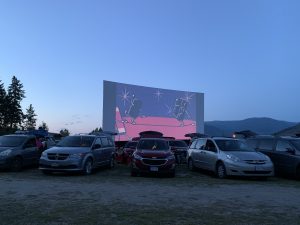
Cars gathered at the drive-in movie theater. Photo Credit: Isabel Wong.
Before this semester, I always thought of presentations as research’s final hurrah. Paper written, edits made, the presentation is simply the bow, the final flourish completing the package. As I’ve learned from this semester, that isn’t always, or even often, the case.
A couple of weeks ago, I found myself needing to give a presentation on a paper I hadn’t yet finished. Perhaps this is a typical predicament, but it was new to me. While I figured I’d limit my presentation to the portion of the paper I had done the most research and work on, I couldn’t simply read aloud those couple of pages. Despite being the most thoroughly researched part of my paper, the pages hadn’t exactly reached clarity nor coherency. Quotes from scholars, while there, were simply plunked in between paragraphs of my own writing, unattached and unanalyzed. I hadn’t gone back and edited the section, which sprawled across the page, repetitious and unnecessarily detailed.
What I needed for the presentation, I decided, was an entirely new script. With my drafted paper open on my screen, I set about picking the draft apart, identifying which details were actually relevant and which I merely liked the sound of. I weaved in the words of scholars to take the place of my own watered-down ones. After, piecing together a PowerPoint, I scoured my phone for photos. Reading the script alongside the PowerPoint, I added in slide cues, practiced a bit more, then went to bed. I had a presentation the next day, after all.
The presentation seemed to go fine. I enjoyed learning about my classmates’ projects, and the Q&A was generative. When it came time to finish my paper, though, it wasn’t others’ comments I found myself returning to. It was the script I had written. As I grappled with how to revise my paper, how to incorporate the theory more fluidly, how to determine where to curb the sprawl and where to let the paper breathe and expand, I came to realize that I had already done much of this work while constructing my presentation script. The presentation’s time constraints had brought questions of length, repetition, focus, and pacing to the forefront. I couldn’t push these considerations to the wayside like I had while drafting the paper itself. The presentation’s economy of minutes helped me determine when my words were valuable and when they lacked the luster of true gold.
Once I saw my presentation as a new starting place rather than simply a side gig I had to fulfill, the work of revising became much lighter. Rather than laboring over every sentence, tying in quotes and building transitions, I simply redirected the script’s ending, opening it up again to the rest of the paper. Given the feedback I had received during the Q&A, I fleshed out the presentation’s middle to solidify a hint into a complete point.
Presentations, I have learned, don’t always come at the end of, nor are they separate from, the research process. Rather, like my professor had mentioned earlier in the semester, they are another place to receive feedback on your research, an intellectual gathering place.
While I don’t think my professor was talking about presentation scripts when she encouraged us to see presentations as grounds for growth, I think her overall sentiment, to be open to changes that your presentation opens up, still stands. Previously, I saw presentations as ta-da moments, final reveals on all the work one had accomplished. Now, I see presentations as a technique of revision, as another medium through which to receive feedback, as a space for generative discussion rather than the final destination.
